|
Chaillot was a separate village until the
19th century, when it was swallowed up by the growing city and bestowed
with wide avenues and lavish mansions during the Second Empire
building spree. Its centrepiece is the glorious Palais de Chaillot
which stands on top of the small Chaillot hill, its wide white-stone
wings embracing the Trocadéro Gardens and its terrace gazing across the
Seine to the Eiffel Tower. Behind the palace is the place du Trocadéro,
laid out in 1858 and originally called the place du Roi-de-Rome (King of
Rome), the title of Napoleon’s son. The square is ringed with smart
cafés, overlooking the central equestrian statue of World War I hero
Marshal Ferdinand Foch. Many of the elegant mansions in this area now
house embassies, and there are numerous fine dining spots. To the west
are the exclusive residential neighbourhoods of the Parisian
bourgeoisie.
|
General Ferdinand Foch (1851–1929), whose statue
stands in the centre of place du Trocadéro, was the commander-in-chief
of the Allied armies by the end of World War I. His masterful command
ultimately led to victory over the Germans in 1918, whereupon he was
made a Marshal of France and elected to the French Academy.
|
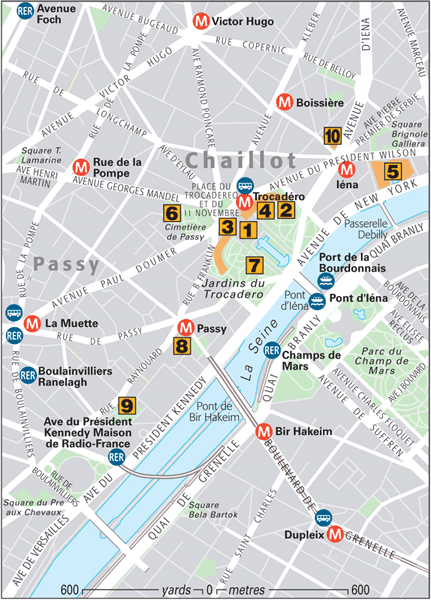
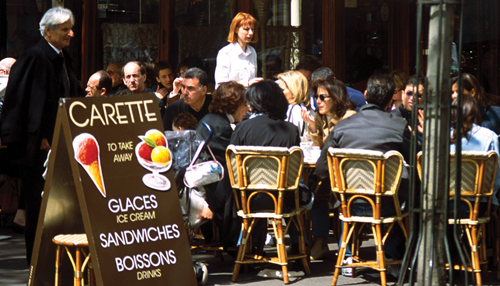
Café Carette
SightsPalais de Chaillot The
fall of his empire scuppered Napoleon’s plans for an opulent palace for
his son on Chaillot hill, but the site was later used for the Trocadéro
palace, built for the Universal Exhibition of 1878. It was replaced by
the present Neo-Classical building with its huge colonnaded wings for
the prewar exhibition of 1937. The two pavilions house three museums,
including the Musée de l’Homme. The broad terrace is the domain of
souvenir sellers and skate-boarders by day, while at night it is crowded
with busloads of tour groups stopping off for the splendid view of the
Eiffel Tower across the Seine. Two bronzes, Apollo by Henri Bouchard and Hercules by Pommier, stand to the front of the terrace. Beneath the terrace is the 1,200-seat Théâtre National de Chaillot.
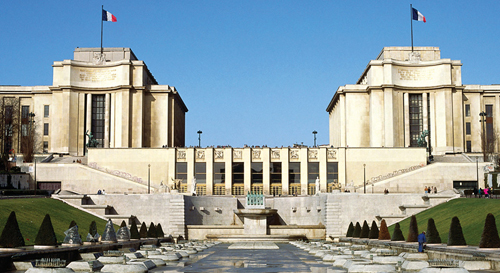
Cinéaqua Originally
built in 1878 for the Universal Exhibition, Paris’ aquarium reopened in
2006 after a 21-year closure. It is home to over 500 species, including
seahorses, stonefish and some spectacular sharks and rays. Built into a
former quarry, the site has been designed to blend in with the Chaillot
hillside. There is also a futuristic cinema complex, the Movieum. Musée de la Marine French
naval history is the focus of this museum, whether in war, trade and
commerce, or industries such as fishing. The displays range from naval
art to science to maritime adventure and popular legends and traditions.
Among the highlights is an outstanding collection of model ships, from
the feluccas of ancient Egypt, to medieval galleys to nuclear
submarines. You can also watch craftsmen at work on the models.
Napoleon’s royal barge is also on show . Palais de Chaillot, 75016 Open 10am–6pm Wed–Mon Closed 1 Jan, 1 May, 25 Dec Admission charge
www.musee-marine.fr
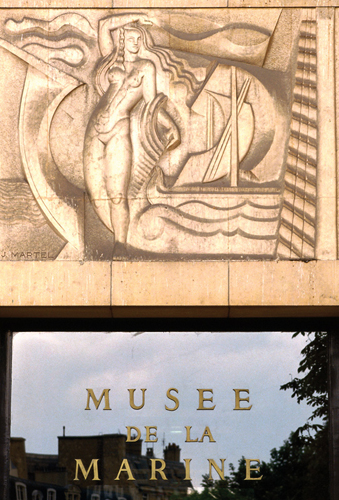
Cité de l’Architecture et du Patrimoine Occupying
the east wing of the Palais Chaillot (together with the Musée de
l’Homme), this museum is a veritable ode to French architectural
heritage, showcasing its development through the ages as well as
contemporary architecture. The Galerie des Moulages (Medieval to
Renaissance) contains moulded portions of churches and great French
cathedrals such as Chartres. The Galerie Moderne et Contemporain
includes a reconstruction of an apartment designed by Le Corbusier, and
architectural designs from 1990 onwards. The wall-painting gallery in
the Pavillon de Tête has a stunning collection of murals copied from
medieval frescoes. Musée d’Art Moderne de la Ville de Paris
This modern art museum is housed in the east wing of the Palais de
Tokyo, built for the 1937 World Fair. Its
permanent collection includes such masters as Chagall, Picasso,
Modigliani and Léger; further highlights include Raoul Dufy’s enormous
mural The Spirit of Electricity (1937), and Picabia’s Lovers (After the Rain)
(1925). The museum is also keen to promote up-and-coming artists by
showcasing their work in frequent temporary exhibitions on the same
site. 11 ave du Président-Wilson, 75016 Open 10am–6pm Tue–Sun (until 10pm Thu during temporary exhibitions) 01 53 67 40 00 Admission charge
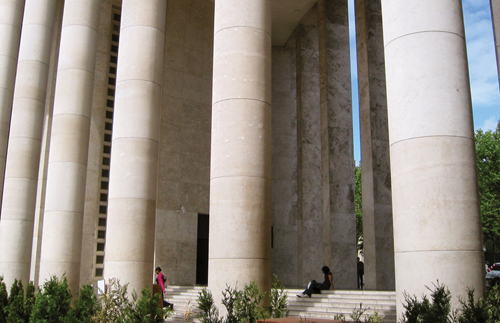
Cimetière de Passy This
small cemetery covers only 1 ha (2.5 acres), yet many famous people
have been laid to rest here with the Eiffel Tower as their eternal view
(see Graves in Cimetière de Passy). It is worth a visit just to admire the striking sculptures on the tombs.
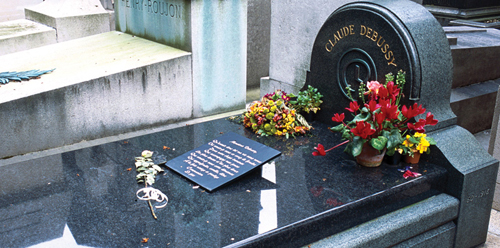
Cimetière de Passy
Jardins du Trocadéro Designed
in 1937, the tiered Trocadéro Gardens descend gently down Chaillot Hill
from the palace to the Seine and the Pont d’Iéna. The centrepiece of
this 10-ha (25-acre) park is the long rectangular pool lined with stone
and bronze statues, including Woman by
Georges Braque (1882–1963). Its illuminated fountains are spectacular at
night. With flowering trees, walkways and bridges over small streams,
the gardens are a romantic place for a stroll . Musée du Vin The
vaulted 14th-century cellars where the monks of Passy once made wine
are an atmospheric setting for this wine museum. Waxwork figures depict
the history of the wine-making process, and there are displays of wine
paraphernalia. There are tasting sessions, wine for sale and a
restaurant.
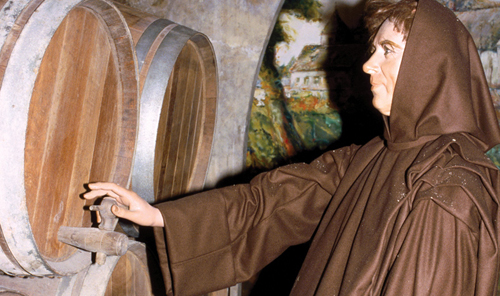
Exhibit at the Musée du Vin
Maison de Balzac The writer Honoré de Balzac rented an apartment here from 1840–44, and assumed a false name to
avoid his many creditors. He worked on several of his famous novels
here, including La cousine Bette and La comédie humaine.
The house is now a museum displaying first editions and manuscripts,
personal mementoes and letters, and paintings and drawings of his
friends and family. 47 rue Raynouard, 75016 Open 10am–6pm Tue–Sun Closed public hols Admission charge
www.balzac.paris.fr
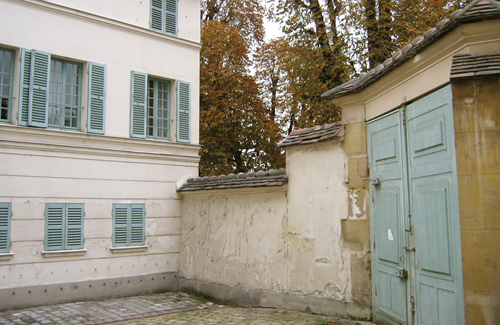
Musée National des Arts Asiatiques-Guimet One
of the world’s foremost museums of Asiatic and Oriental art, founded by
industrialist Emile Guimet in Lyon in 1879. The Khmer Buddhist temple
sculptures from Angkor Wat are the highlight of the finest collection of
Cambodian art in the west. Guimet’s original collection tracing Chinese
and Japanese religion from the 4th to 19th centuries is also on
display, as are artifacts from India, Indonesia and Vietnam. 6 pl d’Iéna, 75016 Open 10am– 6pm Wed–Mon Admission charge
www.guimet.fr
|